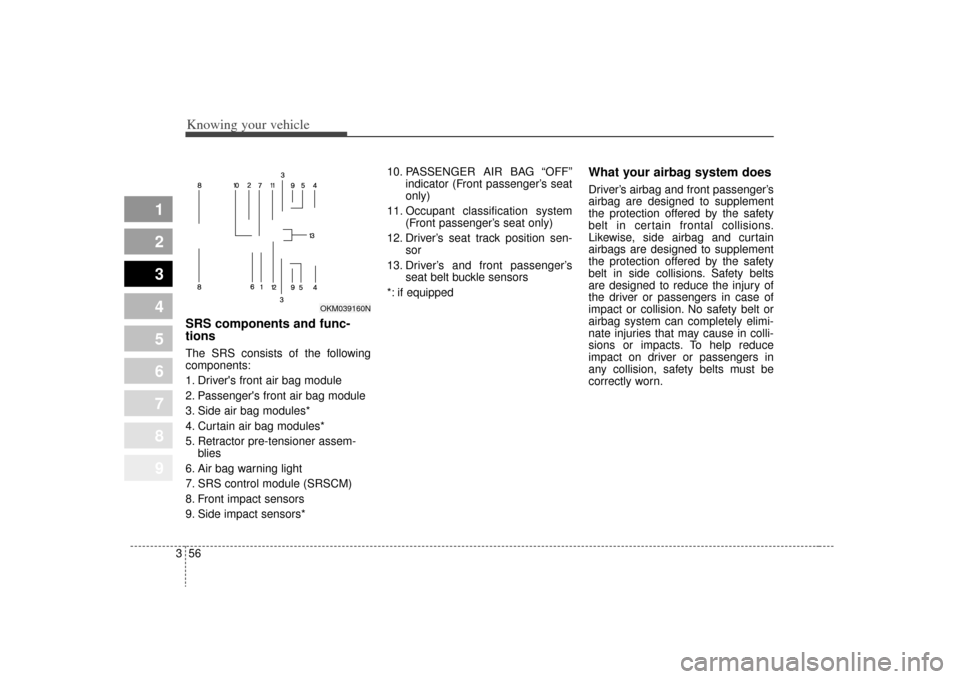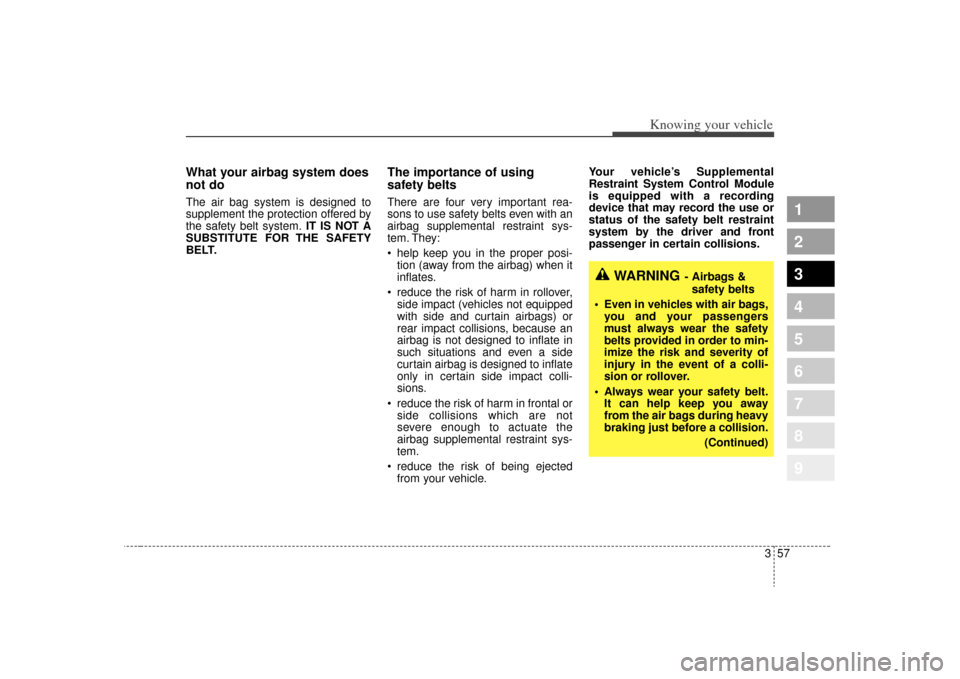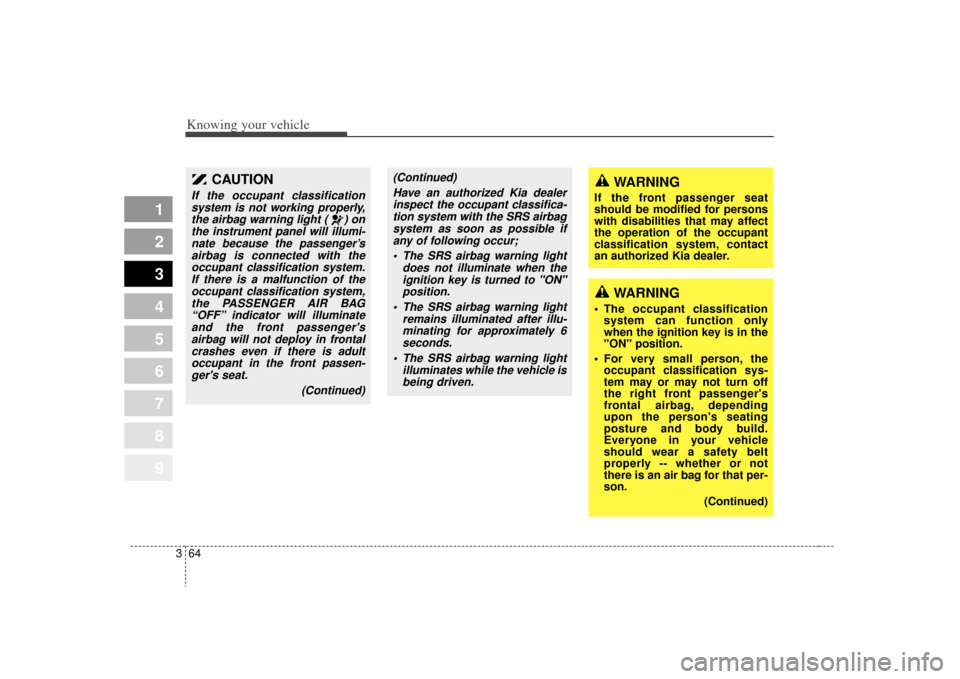2009 KIA Sportage airbag off
[x] Cancel search: airbag offPage 65 of 371

Knowing your vehicle56
3
1
2
3
4
5
6
7
8
9
SRS components and func-
tionsThe SRS consists of the following
components:
1. Driver's front air bag module
2. Passenger's front air bag module
3. Side air bag modules*
4. Curtain air bag modules*
5. Retractor pre-tensioner assem-
blies
6. Air bag warning light
7. SRS control module (SRSCM)
8. Front impact sensors
9. Side impact sensors* 10. PASSENGER AIR BAG “OFF”
indicator (Front passenger’s seat
only)
11. Occupant classification system (Front passenger’s seat only)
12. Driver’s seat track position sen- sor
13. Driver’s and front passenger’s seat belt buckle sensors
*: if equipped
What your airbag system doesDriver’s airbag and front passenger’s
airbag are designed to supplement
the protection offered by the safety
belt in certain frontal collisions.
Likewise, side airbag and curtain
airbags are designed to supplement
the protection offered by the safety
belt in side collisions. Safety belts
are designed to reduce the injury of
the driver or passengers in case of
impact or collision. No safety belt or
airbag system can completely elimi-
nate injuries that may cause in colli-
sions or impacts. To help reduce
impact on driver or passengers in
any collision, safety belts must be
correctly worn.
OKM039160N
Page 66 of 371

357
1
2
3
4
5
6
7
8
9
Knowing your vehicle
What your airbag system does
not doThe air bag system is designed to
supplement the protection offered by
the safety belt system.IT IS NOT A
SUBSTITUTE FOR THE SAFETY
BELT.
The importance of using
safety beltsThere are four very important rea-
sons to use safety belts even with an
airbag supplemental restraint sys-
tem. They:
help keep you in the proper posi- tion (away from the airbag) when it
inflates.
reduce the risk of harm in rollover, side impact (vehicles not equipped
with side and curtain airbags) or
rear impact collisions, because an
airbag is not designed to inflate in
such situations and even a side
curtain airbag is designed to inflate
only in certain side impact colli-
sions.
reduce the risk of harm in frontal or side collisions which are not
severe enough to actuate the
airbag supplemental restraint sys-
tem.
reduce the risk of being ejected from your vehicle. Your vehicle’s Supplemental
Restraint System Control Module
is equipped with a recording
device that may record the use or
status of the safety belt restraint
system by the driver and front
passenger in certain collisions.
WARNING
- Airbags &
safety belts
Even in vehicles with air bags, you and your passengers
must always wear the safety
belts provided in order to min-
imize the risk and severity of
injury in the event of a colli-
sion or rollover.
Always wear your safety belt. It can help keep you away
from the air bags during heavy
braking just before a collision.
(Continued)
Page 68 of 371

359
1
2
3
4
5
6
7
8
9
Knowing your vehicle
The advanced SRS offers the ability
to control the airbag inflation with two
levels. A first stage level is provided
for moderate-severity impacts. A sec-
ond stage level is provided for more
severe impacts.
According to the impact severity,
seating position and safety belt
usage, the SRS Control Module con-
trols the airbag inflation.
Additionally, your SRS is equipped
with an occupant classification sys-
tem in the front passenger’s seat.
The occupant classification system
detects the presence of a passenger
in the front passenger’s seat and will
turn off the front passenger’s airbag
under certain conditions in order to
protect smaller front passenger seat
occupants. For more detail, see
“Occupant Classification System”
later in this section.
WARNING
- Seating sen-
sors malfunction
If the seat position sensor is not
working properly, the airbag
warning light ( ) on the instru-
ment panel will illuminate
because the airbag warning
light is connected with the seat
position sensor. If the airbag
warning light does not illumi-
nate when the ignition key is
turned to the "ON" position, if it
remains illuminated after illumi-
nating for approximately 6 sec-
onds, or if it illuminates while
the vehicle is being driven, have
an authorized Kia dealer inspect
your vehicle as soon as possi-
ble.
WARNING
- Seat usage
Modification to the seat struc- ture can damage the seat
position sensor and cause the
airbag to deploy at a different
level than should be provided.
Do not place any objects underneath the front seats
since they could damage the
seat position sensor or inter-
fere with the occupant classi-
fication system.
Do not place any objects that may cause magnetic fields
near the front seat. These may
cause a malfunction of the
seat position sensor.
(Continued)
Page 70 of 371

361
1
2
3
4
5
6
7
8
9
Knowing your vehicle
Front passenger’s airbagFront passenger’s airbag is stored in
the instrument panel on the glove
box.
Never put any objects or ornaments
on the instrument panel.
Occupant classification systemThe occupant classification system
detects the presence of a passenger
in the front passenger’s seat and will
turn off the front passenger’s airbag
under certain conditions.
The occupant classification system is
designed to detect the presence of a
properly-seated occupant and deter-
mine if the front passenger’s airbag
should be enabled (may inflate) or
not.If there is no passenger in the front
passenger seat or if the passenger in
the front passenger's seat is very
small (such as a child), the front PAS-
SENGER AIR BAG “OFF” indicator
may go ON.
When this indicator is ON, the front
passenger's air bag will not deploy.
The side air bag will not deploy if the
front seat is unoccupied.
The side air bag may deploy if the
front seat is occupied by a small
occupant.
1KMN3162
1KMA2058HLZ2121
OKM039200N
Page 71 of 371

Knowing your vehicle62
3
1
2
3
4
5
6
7
8
9
Main components of occupant
classification system A detection device located within
the front passenger seat cushion.
Electronic system to determine whether passenger air bag sys-
tems (both front and side) should
be activated or deactivated.
A warning light located on the instrument panel which illuminates
the words PASSENGER AIR BAG
“OFF” indicating the front passen-
ger air bag system is deactivated.
The instrument panel air bag warn- ing light is interconnected with the
occupant classification system. Always be sure that you and all vehi-
cle occupants are seated and
restrained properly (sitting upright
with the seat in an upright position,
centered on the seat cushion, with
the person’s legs comfortably
extended, feet on the floor, and wear-
ing the safety belt properly) for the
most effective protection by the air
bag and the safety belt.
The OCS may not function proper-
ly if the passenger takes actions
which can defeat the detection sys-
tem. These include:
(1) Failing to sit in an upright posi- tion.
(2) Leaning against the door or cen- ter console.
(3) Sitting towards the sides or the front of the seat.
(4) Putting legs on the dashboard or resting them on other locations
which reduce the passenger
weight on the front seat.
(5) Improperly wearing the safety belt.
(6) Reclining the seat back. The PASSENGER AIR BAG “OFF”
indicator illuminates after the igni-
tion key is turned to the “ON” posi-
tion or after the engine is started. If
the front passenger’s seat is occu-
pied by very small person, the
PASSENGER AIR BAG “OFF” indi-
cator will remain illuminated. If the
front passenger’s seat is occupied
by a person of adult size, the PAS-
SENGER AIR BAG “OFF” indicator
will turn off after 4 seconds.
If the front passenger's seat is unoccupied, the PASSENGER AIR
BAG “OFF” indicator will turn on,
and the front passenger's airbag
will not deploy in frontal crashes.
If the PASSENGER AIR BAG “OFF” indicator illuminates, the
front passenger’s airbag will not
deploy in frontal crashes.
If the front passenger’s seat is occupied by a person of adult size,
the PASSENGER AIR BAG “OFF”
indicator is not illuminated and the
front passenger’s airbag will deploy
in frontal crashes.
Page 72 of 371

363
1
2
3
4
5
6
7
8
9
Knowing your vehicle
CAUTION
If the PASSENGER AIR BAG“OFF” indicator illuminates orblinks continuously when a per-son of adult size sits in the frontpassenger’s seat, it could bebecause that person isn’t sittingproperly in the seat.
If this happens, turn the vehicleoff, place the seat back in thefull upright position, sit uprightin the seat, centered on the seatcushion, with legs comfortablyextended. Restart the vehicleand have the person remain inthis position for about 1 minute.This will allow the system todetect the person and enablethe passenger’s airbag.
Condition and operation in the front passenger occupant
classification systemCondition detected by
the occupant classifi- cation system
1. Adult *
1
2. Child *
2
3. Unoccupied
4. There is a malfunc- tion in the system Off
On
On
On Off
Off
Off
On Activated
Deactivated
Deactivated
Deactivated
PASSENGER AIR BAG “OFF” indicator light
Airbag warning light Front passenger
airbag
Indicator/Warning light Devices
*1The system judges a person of adult size as an adult. When a smaller adult
sits in the front passenger seat, the system may recognize him/her as a
child depending on his/her physique and posture.
*2When a larger child who has outgrown a child restraint system sits in the front passenger seat, the system may recognize him/her as an adult
depending on his/her physique or posture.
Page 73 of 371

Knowing your vehicle64
3
1
2
3
4
5
6
7
8
9
CAUTION
If the occupant classification
system is not working properly,the airbag warning light ( ) onthe instrument panel will illumi-nate because the passenger’sairbag is connected with theoccupant classification system.If there is a malfunction of theoccupant classification system,the PASSENGER AIR BAG“OFF” indicator will illuminateand the front passenger'sairbag will not deploy in frontalcrashes even if there is adultoccupant in the front passen-ger's seat.
(Continued)
(Continued)Have an authorized Kia dealerinspect the occupant classifica-tion system with the SRS airbagsystem as soon as possible ifany of following occur;
The SRS airbag warning light does not illuminate when theignition key is turned to "ON"position.
The SRS airbag warning light remains illuminated after illu-minating for approximately 6seconds.
The SRS airbag warning light illuminates while the vehicle isbeing driven.
WARNING
The occupant classification system can function only
when the ignition key is in the
"ON" position.
For very small person, the occupant classification sys-
tem may or may not turn off
the right front passenger's
frontal airbag, depending
upon the person's seating
posture and body build.
Everyone in your vehicle
should wear a safety belt
properly -- whether or not
there is an air bag for that per-
son.
(Continued)
WARNING
If the front passenger seat
should be modified for persons
with disabilities that may affect
the operation of the occupant
classification system, contact
an authorized Kia dealer.
Page 74 of 371

365
1
2
3
4
5
6
7
8
9
Knowing your vehicle
(Continued)
If the front seat passengerchanges their seating position
(for example, by not sitting
upright, by sitting on the edge
of the seat, or by otherwise
being out of position), the
PASSENGER AIR BAG “OFF”
indicator may be turned on,
and the passenger's airbag
may not deploy in a collision.
Always be sure to sit properly
in the front passenger’s seat
and wear the safety belt prop-
erly and do not do any of the
following.
(Continued)
(Continued)
- Put a heavy load in the frontpassenger seat.
- Excessively recline the front passenger seatback.
(Continued)
1KMN36611KMN3662
(Continued)
- Sit with hips shifted towardsthe front of the seat.
- Lean on the center console.
- Sit on one side of the front passenger seat. (Continued)
1KMN36631KMN3664